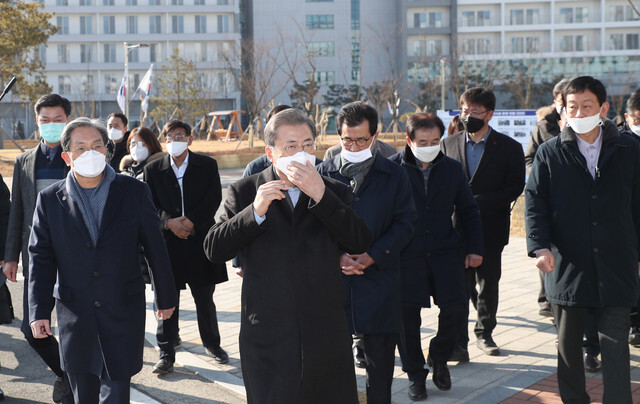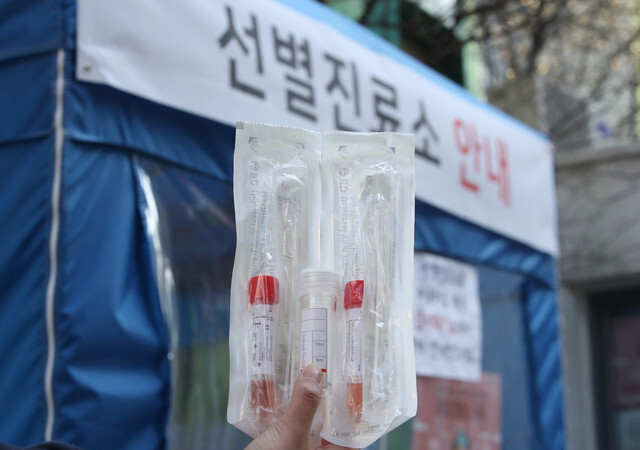hankyoreh
Links to other country sites 다른 나라 사이트 링크
S. Korea advises citizens against traveling to Southeast Asia and Japan

Given the increasing number of South Koreans who’ve contracted the novel coronavirus on trips to countries other than China, such as Japan, Thailand, and Singapore, the South Korean government is urging its citizens to minimize trips to countries in Southeast Asia that have seen a large number of cases of the infection. While Seoul had been leaning toward extending the entry ban from people from Hubei Province to other at-risk regions of China, it shifted course by deciding not to extend the ban. Those were some of the main measures adopted by the government on Feb. 9 during an expanded meeting of its central disease control headquarters, with Prime Minister Chung Sye-kyun presiding.
“We will provide infectious disease data to countries and regions dealing with the local transmission of the disease in order to prevent infected individuals from entering the country from regions other than China. We will also recommend [that South Koreans] minimize traveling [to those countries] simply for the purpose of tourism, unless absolutely necessary,” Minister of Health and Welfare Park Neung-hoo told reporters after the meeting.
This is the first time since the outbreak of the coronavirus that the government has asked citizens to refrain from traveling to countries other than China. This measure comes in response to the increasing number of South Koreans who have been infected in countries other than China, such as Japan, Thailand, and Singapore. However, this recommendation is not part of the Ministry of Foreign Affairs’ four-stage travel alert system. (The four stages are “caution while traveling,” “refrain from traveling,” “evacuation recommended,” and “travel forbidden”).
Medical facilities will now have more access to information about patients’ travel history in these countries. Going forward, hospitals and pharmacies will be able to check the travel history of people who have visited not only China but also countries in Southeast Asia using the examinee qualification verification system, the international traveler information system, and the drug utilization review. Access will be expanded to information pertaining to Singapore, Thailand, and Vietnam on Feb. 11, to Japan and Hong Kong on Feb. 13, and to Taiwan, Malaysia, and Macao on Feb. 17.

On Monday, the South Korean government also announced that it would be arranging a third charter flight to bring home South Koreans still trapped in Wuhan. The flight is scheduled to arrive in South Korean on the morning of Feb. 12. At the time of the first and second charter flights, the Chinese authorities had barred people of Chinese nationality from leaving the country, even if they had South Korean family members, but on Feb. 5 it changed its stance on that issue. While there are reportedly some 230 South Korean citizens and family members still on the ground in Wuhan, a government survey found that 100 or so intend to sign up for the charter flight. The actual number of passengers, however, is expected to be around 150.
After arriving in South Korea, the passengers will be quarantined at a national defense language institute in Icheon, Gyeonggi Province, for 14 days.
However, the South Korean government has decided not to extend the entry ban to other parts of China. While Chung said at the beginning of the meeting on Sunday that the government “may consider the additional measure of restricting entry from other at-risk regions of China that are seeing a large number of infections,” that wasn’t mentioned in the government’s announcement of the meeting’s results. Seoul appears to be very cautious about the idea of imposing further entry bans on China, in light of relations with its important neighbor.
“The number of people entering from China has fallen by about 60% between Feb. 2 and 8, from 13,000 to 5,200. [In line with the majority opinion at the meeting,] we’ve decided to stick with the status quo a little longer, until there’s a major change in the situation,” said Park Neung-hoo.
There had been 30,000 people entering South Korea from China each day, but that number continues to drop following the adoption of stronger quarantine measures and special entry procedures.
“During the five days [from the adoption of the entry ban] until Feb. 8 there were 499 cases of people who were denied entry from China for various reasons, such as being in possession of a passport issued in Hubei Province,” said Park.
On Sunday, a 51-year-old South Korean male who had visited China’s Guangdong Province, his 37-year-old Chinese wife, and his 73-year-old South Korean mother, who lives with the couple, all tested positive for the coronavirus. That brings the total number of confirmed cases in South Korea to 27.
By Noh Ji-won and Park Su-ji, staff reporters
Please direct comments or questions to [english@hani.co.kr]

Editorial・opinion
![[Column] Park Geun-hye déjà vu in Yoon Suk-yeol [Column] Park Geun-hye déjà vu in Yoon Suk-yeol](https://flexible.img.hani.co.kr/flexible/normal/500/300/imgdb/original/2024/0424/651713945113788.jpg) [Column] Park Geun-hye déjà vu in Yoon Suk-yeol
[Column] Park Geun-hye déjà vu in Yoon Suk-yeol![[Editorial] New weight of N. Korea’s nuclear threats makes dialogue all the more urgent [Editorial] New weight of N. Korea’s nuclear threats makes dialogue all the more urgent](https://flexible.img.hani.co.kr/flexible/normal/500/300/imgdb/original/2024/0424/7317139454662664.jpg) [Editorial] New weight of N. Korea’s nuclear threats makes dialogue all the more urgent
[Editorial] New weight of N. Korea’s nuclear threats makes dialogue all the more urgent- [Guest essay] The real reason Korea’s new right wants to dub Rhee a founding father
- [Column] ‘Choson’: Is it time we start referring to N. Korea in its own terms?
- [Editorial] Japan’s rewriting of history with Korea has gone too far
- [Column] The president’s questionable capacity for dialogue
- [Column] Are chaebol firms just pizza pies for families to divvy up as they please?
- [Column] Has Korea, too, crossed the Rubicon on China?
- [Correspondent’s column] In Japan’s alliance with US, echoes of its past alliances with UK
- [Editorial] Does Yoon think the Korean public is wrong?
Most viewed articles
- 1[Guest essay] The real reason Korea’s new right wants to dub Rhee a founding father
- 2Why Korea shouldn’t welcome Japan’s newly beefed up defense cooperation with US
- 3[Column] ‘Choson’: Is it time we start referring to N. Korea in its own terms?
- 4New AI-based translation tools make their way into everyday life in Korea
- 5[Column] Park Geun-hye déjà vu in Yoon Suk-yeol
- 6Senior doctors cut hours, prepare to resign as government refuses to scrap medical reform plan
- 7Opposition calls Yoon’s chief of staff appointment a ‘slap in the face’
- 8Will NewJeans end up collateral damage in internal feud at K-pop juggernaut Hybe?
- 9Terry Anderson, AP reporter who informed world of massacre in Gwangju, dies at 76
- 10Thursday to mark start of resignations by senior doctors amid standoff with government